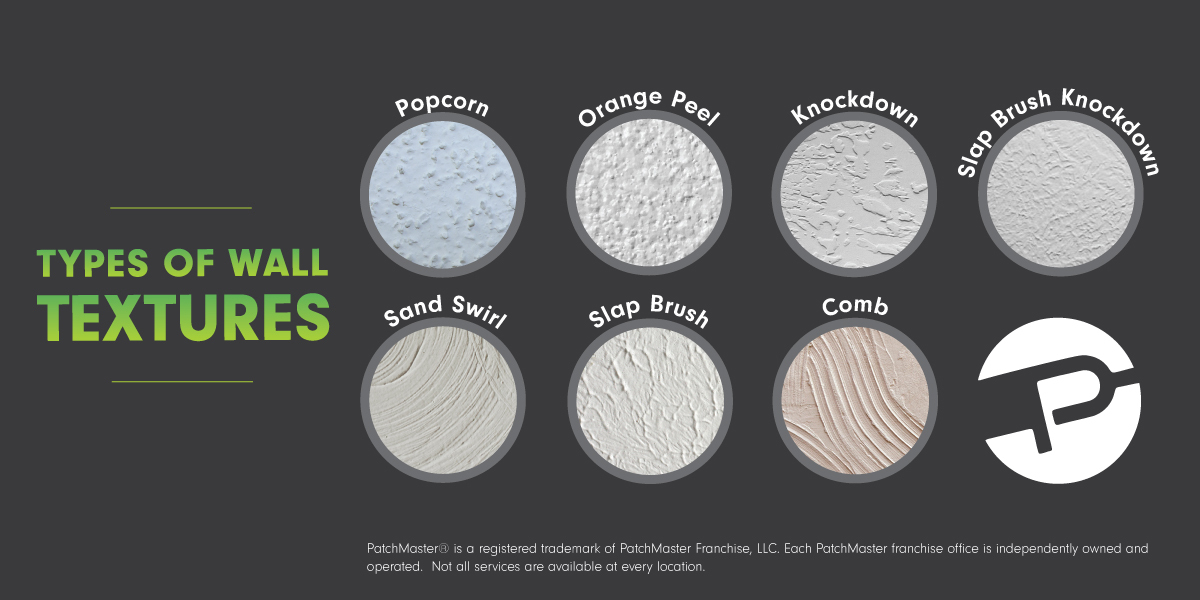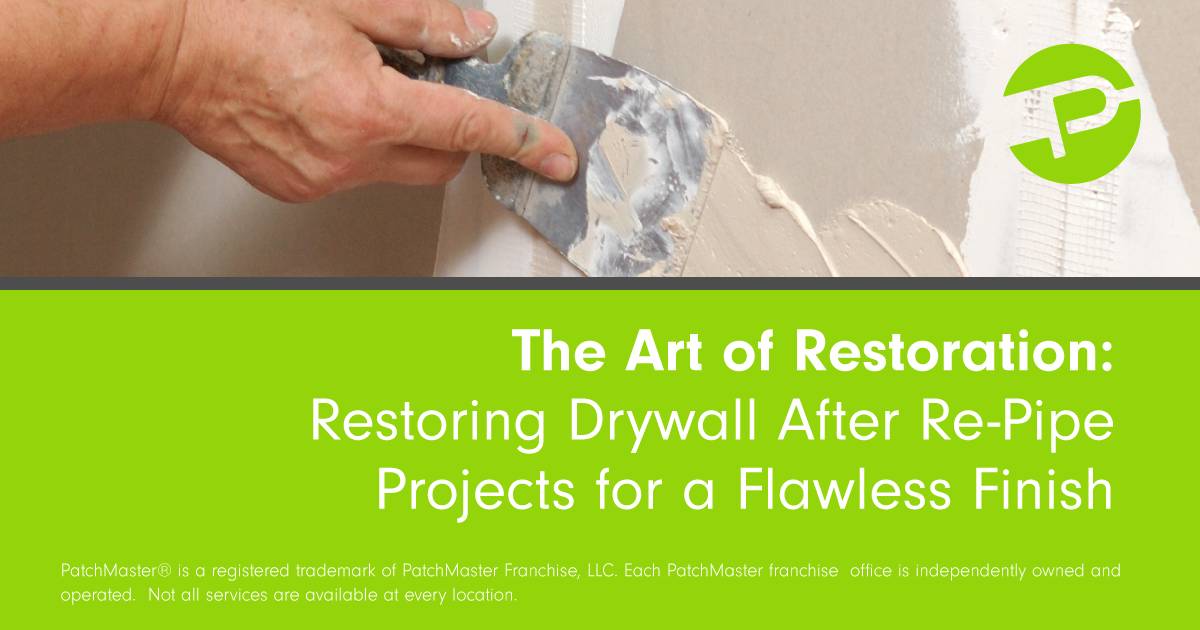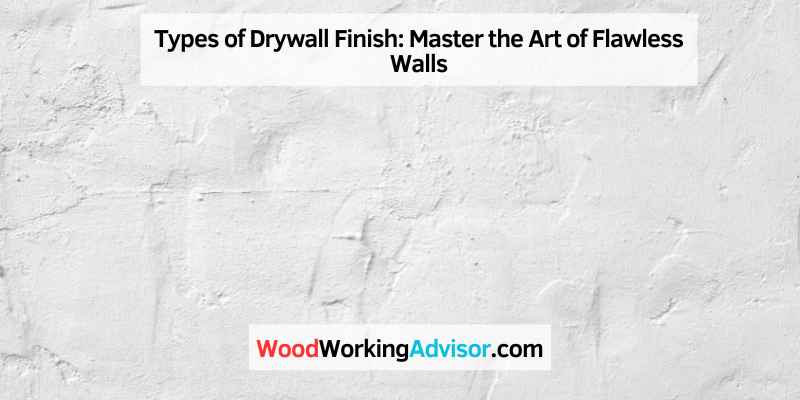Drywall finishes include smooth, textured, sand swirl, skip trowel, and orange peel. Different finishes offer various visual effects and textures, enhancing the overall appearance of a room or space.
Each type of drywall finish has its unique characteristics and is suited for different design preferences and purposes. It is essential to select the right type of finish that complements the style of the room and meets the desired aesthetic goals.
Understanding the different options available and their features can help in making an informed decision when it comes to selecting the ideal drywall finish for a project. Let’s explore these finishes in more detail to help you choose the most suitable one for your needs.

Credit: patchmaster.com
Different Types Of Drywall Finishes
When finishing a drywall project, different levels of finishing are used to achieve the desired smoothness and appearance. These levels range from Level 0 to Level 5, each serving a specific purpose. Let’s explore the different types of drywall finishes:
Level 0 Finish
Level 0 finish is the most basic form of drywall finish and involves simply taping the joints and applying joint compound. No further finishing is done beyond this point.
Level 1 Finish
Level 1 finish involves the same process as Level 0 but with an additional step of concealing the joints and fasteners. This finish is typically used in areas that will be covered by another material.
Level 2 Finish
Level 2 finish includes the steps of Level 1 but further involves applying a thin skim coat over the entire surface to provide a smoother appearance. This finish is suitable for areas that will be textured or painted.
Selecting The Right Drywall Finish For Your Project
When selecting the right drywall finish for your project, it’s crucial to consider various factors that can impact the overall outcome of the project. From the purpose of the space to your desired aesthetic and budget constraints, each aspect plays a significant role in determining the most suitable drywall finish.
Considering The Purpose Of The Space
- Assess how the space will be used to determine the appropriate level of durability needed for the drywall finish.
- Areas with high traffic, such as hallways and entryways, may require a more robust finish to withstand wear and tear.
Assessing Desired Aesthetic
- Consider the overall design style of the space to choose a drywall finish that complements the aesthetic appeal.
- Textured finishes can add visual interest and depth to a room, while smooth finishes offer a more modern and clean look.
Budget And Time Constraints
Evaluate your budget constraints to ensure the selected drywall finish aligns with your financial limitations. Additionally, consider the time frame for the project to determine if a more labor-intensive finish is feasible within the given timeframe.
Mastering The Art Of Applying Drywall Finishes
Drywall finishing is a crucial skill that can elevate the overall appearance of a space. Understanding the different types of drywall finishes and techniques is essential for achieving professional-level results. From preparation and priming to troubleshooting common issues, each step requires precision and attention to detail.
Preparation And Priming
Before applying any drywall finish, it’s vital to prepare the surface adequately. Ensure that all imperfections, such as dents or protruding nails, are addressed. Additionally, proper priming is essential to promote adhesion and create a smooth base for the finish.
Techniques For Each Finish Level
There are different levels of drywall finish, ranging from level 0 to level 5. Mastering the techniques for each level is crucial. Whether it’s taping, mudding, or sanding, understanding the nuances of each technique is paramount to achieving a flawless finish.
Troubleshooting Common Issues
Despite meticulous efforts, issues may arise during the drywall finishing process. Common problems such as blistering, joint ridging, or uneven texture can occur. Knowing how to troubleshoot and rectify these issues is essential to maintain the quality of the finish.

Credit: mississaugahandyman.com
Tools And Materials For Achieving Flawless Walls
Achieving flawless walls requires the right tools and materials, especially when it comes to the type of drywall finish. From joint compound to textured finishes, the options are versatile and can significantly impact the final look of your walls. Understanding the different types of drywall finish is essential for a seamless and polished result.
Achieving flawless walls requires the right tools and materials. Whether you are a DIY enthusiast or a professional contractor, having the essential tools for drywall finishing is crucial. Additionally, understanding the different types of joint compounds and choosing the right sandpaper can make a significant difference in the final result. In this section, we will explore the essential tools for drywall finishing, the types of joint compounds available, and the importance of choosing the right sandpaper.
Essential Tools For Drywall Finishing
To achieve a flawless drywall finish, you need to have the right tools at your disposal. Here are the essential tools you will need for this project:
1. Taping Knife: A taping knife or a drywall knife is one of the most important tools for applying joint compound and smoothing it over the seams. Choose a taping knife with a flexible yet sturdy blade for optimal results.
2. Sanding Sponge: A sanding sponge is a versatile tool that allows you to smooth out imperfections and blend the joint compound seamlessly. It is essential for achieving a smooth, even surface.
3. Mud Pan: A mud pan is used to hold the joint compound while you work. It provides easy access to the compound, allowing for quick and efficient application.
4. Putty Knife: A putty knife is a smaller version of the taping knife and is excellent for patching small holes and applying compound to small areas.
5. Drywall Sandpaper: Fine-grit sandpaper is crucial for achieving a smooth finish. Choose sandpaper with a grit between 120 and 220 for the best results.
Types Of Joint Compounds
There are two main types of joint compounds available: ready-mixed and setting-type compounds.
1. Ready-Mixed Joint Compound: Ready-mixed joint compound comes premixed and is ready to use straight out of the container. It is convenient and easy to work with, making it a popular choice for many DIY enthusiasts and professionals. Ready-mixed joint compound is available in different drying times, ranging from a few hours to overnight.
2. Setting-Type Joint Compound: Setting-type joint compound, also known as drywall mud, needs to be mixed with water before use. It has a quicker drying time compared to ready-mixed compounds, making it ideal for situations where time is of the essence. Setting-type joint compound is available in various setting times, such as 20 minutes, 45 minutes, and 90 minutes.
Choosing The Right Sandpaper
Choosing the right sandpaper is crucial for achieving a smooth and flawless finish. Here are a few factors to consider when selecting sandpaper for drywall finishing:
1. Grit Size: The grit size determines how coarse or fine the sandpaper is. For drywall finishing, opt for a fine-grit sandpaper between 120 and 220. This range allows for effective smoothing without damaging the surface.
2. Sandpaper Type: Drywall sandpaper is available in both sheets and rolls. Sheets are ideal for small projects and hand sanding, while rolls are more suitable for larger areas and power sanding.
3. Sandpaper Grade: Sandpaper is graded according to its durability. Look for sandpaper labeled as “long-lasting” or “high durability” as it will withstand the rigors of drywall finishing without wearing out quickly.
Remember, using the right tools and materials can make your drywall finishing project easier and help you achieve professional-grade results. Choose the appropriate tools, joint compounds, and sandpaper for your project and take your drywall finish to the next level.
Enhancing Drywall Finishes With Textures And Decorative Techniques
Drywall is a versatile material that allows for a myriad of creative possibilities. With the right textures and decorative techniques, you can transform a plain and simple drywall surface into a work of art. In this section, we will explore various types of drywall textures, how to incorporate decorative finishes, and provide tips for creating custom effects.
Types Of Drywall Textures
Drywall textures add depth and character to your walls, creating visual interest in any space. Here are some popular types of drywall textures:
1. Orange Peel Texture: This texture resembles the peel of an orange, with a slightly bumpy surface. It is achieved by spraying joint compound onto the drywall and then lightly knocking it down with a trowel.
2. Knockdown Texture: This texture creates a stucco-like finish with subtle ridges and valleys. It is achieved by spraying joint compound onto the walls and then using a trowel to flatten and lightly texture the surface.
3. Skip Trowel Texture: This texture creates a hand-applied, rustic look with a random pattern of swirls and curves. It is achieved by applying joint compound with a trowel in a skipping motion, creating a textured surface.
4. Popcorn Texture: This texture is known for its distinctive bumpy appearance, reminiscent of popcorn. While it was popular in the past, it is no longer widely used due to its outdated and difficult-to-maintain nature.
5. Sand Swirl Texture: This texture involves swirling joint compound onto the walls with a trowel to create a sand-like pattern. It adds texture while maintaining a smooth finish.
Incorporating Decorative Finishes
Decorative finishes can take your drywall to the next level, adding elegance and personality to your space. Here are some popular techniques for incorporating decorative finishes:
1. Venetian Plaster: Venetian plaster creates a luxurious marble-like finish with a smooth and shiny appearance. It involves applying multiple layers of plaster followed by buffing and burnishing to create a glossy finish.
2. Stenciling: Stenciling allows you to add intricate patterns or designs to your drywall. Simply place a stencil over the wall and apply paint or texture through the stencil to create a personalized design.
3. Faux Finishes: Faux finishes mimic the appearance of materials such as stone, wood, or metal. They can be achieved through various techniques like color washing, glazing, or sponging.
4. Wallpaper: Wallpaper is an easy way to add texture and patterns to your drywall. Choose from a wide range of wallpaper designs and textures to suit your style and create a unique look.
Tips For Creating Custom Effects
Creating custom effects allows you to unleash your creativity and make your drywall truly one-of-a-kind. Here are some tips to help you create custom effects:
- Experiment with different tools: Explore different tools like brushes, sponges, or rollers to achieve unique textures and patterns on your drywall.
- Layer different textures: Combine multiple textures to create depth and interest. You can incorporate a smooth base texture and add a contrasting textured pattern on top.
- Play with color: Experiment with different paint colors to enhance the texture and create a visually striking effect. Consider using complementary colors or shades for added impact.
- Practice on a sample board: Before applying your chosen texture or finish to your entire wall, practice on a small sample board to perfect your technique and ensure the desired result.
- Seek professional advice: If you’re unsure about the best technique or texture for your space, don’t hesitate to consult a professional. They can provide guidance and help you achieve the desired effect.
By incorporating textures and decorative techniques, you can transform your drywall into a captivating focal point in any room. Whether you prefer a subtle texture or want to make a bold statement, there are endless possibilities to explore. Let your imagination soar and create a space that reflects your unique style and personality.

Credit: patchmaster.com
Frequently Asked Questions For Types Of Drywall Finish
What Are The Different Types Of Drywall Finish?
Drywall finish comes in various types, including smooth finish, textured finish, orange peel finish, skip trowel finish, and knockdown finish. Each type has its own unique appearance and texture, allowing homeowners to choose the one that best suits their preferences and the overall style of their space.
How Do I Achieve A Smooth Finish On Drywall?
To achieve a smooth finish on drywall, start by applying joint compound evenly to the seams and screw holes. Use a trowel or putty knife to scrape off any excess compound and create a flat surface. Allow the compound to dry, then sand the surface gently to create a smooth finish before applying primer and paint.
What Is Textured Drywall Finish?
Textured drywall finish adds visual interest and depth to walls. It can be achieved using various techniques, such as applying texturing compound with a roller, using a specialized spray machine, or applying joint compound with a trowel. Textured finishes can range from subtle patterns to more pronounced textures, depending on the desired effect.
Conclusion
In essence, choosing the right drywall finish is crucial for achieving the desired look and feel in interior spaces. By understanding the various types of drywall finish available, you can make informed decisions that best suit your needs. Whether it’s smooth, textured, or treated, each finish has its unique characteristics to enhance the overall aesthetic of a space.
Ultimately, the right finish can transform a room into a refined and polished setting.


